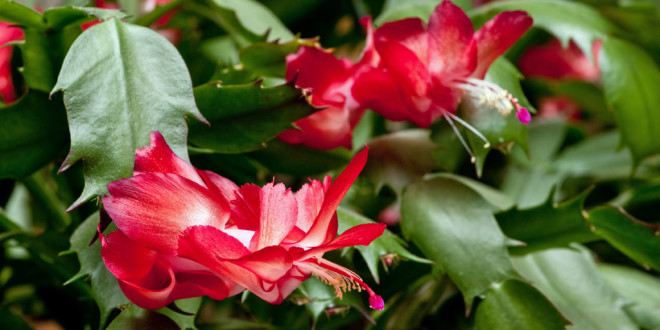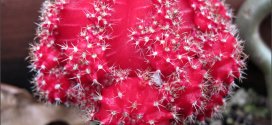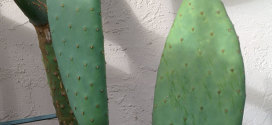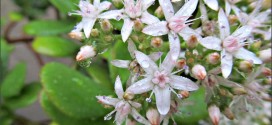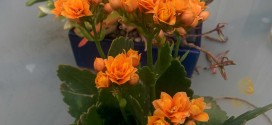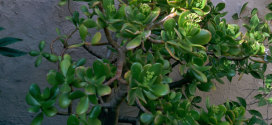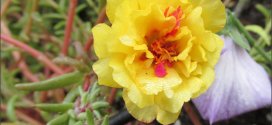Christmas cactus can be grown outdoors in Sunnyvale. Christmas cactus (Schlumbergera bridgesii) and Thanksgiving cactus are popular, fall- and winter-flowering houseplants native to Brazil, and are available in a wide variety of colors including red, rose, purple, lavender, peach, orange, cream, and white. These Schlumbergera species grow as epiphytes among tree branches in shady rain forests, and their pendulous stems make them a great choice for hanging baskets.
When grown under normal night length conditions, Thanksgiving cacti normally flower near Thanksgiving approximately a month before Christmas cacti bloom. Another member of the group sold as holiday cacti is the Easter cactus (Rhipsalidopsis gaertneri), which flowers primarily in the spring and sporadically throughout the year with pink or red flowers. Because of its bloom time, the Thanksgiving cactus is most predominately encountered for sale during the winter holiday season. Flowering can last up 7 to 8 weeks if the plants are kept at 68 ºF.
To distinguish between the Thanksgiving and Christmas cacti, look at the shape of the flattened stem segments, which are botanically called phylloclades. On the Thanksgiving cactus, these stem segments each have 2 to 4 saw-toothed serrations or projections along the margins. The stem margins on the Christmas cactus are more rounded. Note that there are no true leaves on either of these holiday cacti, so photosynthesis occurs within the green phylloclades.
A second method to distinguish between these two Schlumbergera species is based on the color of the pollen bearing anthers. The anthers of the Thanksgiving cactus are yellow, whereas the anthers on the Christmas cactus are purplish-brown.
Culture
Light & Temperature: The holiday cacti grow best in light shade. Full sunlight is beneficial during fall and winter, but bright sun during the summer months can make plants look pale and yellow. Ideal spring and summer growth occurs at temperatures between 70 to 80 °F during its growing season from April to September. During the fall, the Thanksgiving and Christmas cacti depend upon shorter day lengths (8 to 10 hours) and cooler temperatures to set their flower buds. Do not let temperatures rise above 90 °F once the flower buds are set in the fall. Continuous warm temperatures can cause flower buds to drop. Do not leave these cacti outside if temperatures will drop below 50 ºF.
The secret of good flower bud production during the fall involves temperature regulation and photoperiod (length of day and night) control. To initiate flower buds the plants need:
Bright light.
Long nights. Fourteen hours or more of continuous darkness each day is required before flower bud set will occur. Long nights should be started about the middle of September and continued for at least 6 continuous weeks for complete bud set. Note that as little as 2 hours of interrupted lighting will inhibit flower bud set. Buds normally will be visible in 3 to 4 weeks. The photoperiod has no effect on flowering once the buds are set.
Fall growing temperatures should be kept between 60 and 68 °F, but as close to 68 ºF as possible for maximum flower production. Plants grown with night temperatures between 50 and 59 ºF will set flower buds regardless of day length, but growth will be slower and bud drop may occur at 50 ºF.
Pinching back the stems in early June to promote branching and more terminals for more flowers.
Pinching (also called leveling) at the end of September to remove any terminal phylloclades that are less than 1 cm (0.4 inch) long and to make all stems approximately the same length. These short and immature stem segments will not initiate flower buds until mature. After a short phylloclade is removed, a flower bud forms on the previous, more mature stem segment.
Watering & Fertilizer: Water the growing medium when it is dry to the touch. The holiday cacti are tolerant of dry, slightly under-watered conditions during the spring and summer. Do not let the soil become waterlogged, especially during the dark days of winter, but do not let the soil completely dry out either. However, following bud set in the fall, the growing medium must be kept evenly moist to prevent flower bud abscission. Never let water stand in the saucer beneath the pot.
Fertilize plants monthly from the time new growth starts in late winter or early spring, and throughout the summer using a one-half strength soluble fertilizer, such as a 20-10-20 or 20-20-20 with trace elements. Holiday cacti have a higher requirement for magnesium than many plants. Fertilize monthly during the growing season with Epsom salts (magnesium sulfate) mixed at 1 teaspoon per gallon of water, but do not apply the same week as the regular fertilizer. Stop fertilization during the late summer for greater flower bud production in the fall.
Thanksgiving cactus with pale pink blossom. James Blake, ©2011 HGIC, Clemson Extension
Growing Media: The holiday cacti flower best when kept somewhat pot bound. Repotting is necessary only about once every three years and is best done in the spring. The potting medium must be well-drained with good aeration, as these epiphytic cacti do not grow well in heavy, wet potting mixes. A good mix may contain 60-80% potting soil with 40-20% perlite. Choose a good brand of potting soil which is pH balanced.
Propagation
Holiday cacti are easy to propagate by cuttings, which are taken in May or June. Pinch off sections of stems with 3 to 5 phylloclades (stem segments) on each. Allow the cut ends of the sections to callus by placing them outdoors in the shade for a day or two. Choose a well-drained potting soil and new or disinfested containers for rooting. Place three cuttings at approximately one inch deep into the potting soil of a 4-inch container, or use 5 cuttings in a 6-inch container. Water the soil well, and cover the plants and rooting container with a clear plastic bag secured with a rubber band around the container. The plastic bag will act as a miniature greenhouse to keep the relative humidity at 100% to enhance rooting. Place the container in bright, indirect light until roots have formed in three to eight weeks. At this time the plastic bag can be removed, and a dilute fertilizer solution can be used at watering.
Problems
The Thanksgiving and Christmas cacti commonly drop unopened flower buds, which may be induced by an excessive number of buds or a sudden change in temperature, light or other environmental factors, such as drying out of the growing medium. Lack of flowering is often due to light interrupting the long night period (14 hours) that is required for flowering initiation to occur. Street lights, car lights or indoor lighting can disrupt the required dark period.
The major disease is root rot, which can be prevented by avoiding excessive watering. Insects and related pests include mealybugs, soft brown scale, red spider mites, aphids and fungus gnats.
